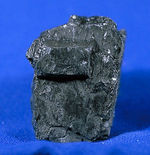Fuel is a material with one type of energy which can be transformed into another usable energy. A common example is potential energy being converted into kinetic energy, (as heat and mechanical work). In many cases this is just something that will burn.
Solid fuels[]

A lump of coal.
There are many different types of fuel. Solid fuels include coal, wood and peat. All these types of fuel are combustible (they create fire and heat). Coal was burnt by Steam locomotives for rail transport to heat water into steam to move parts and provide power. Peat and wood are mainly used for domestic and industrial heating, though peat has been used for power generation, and wood-burning steam locomotives were common in times past. Steam power is becoming more and more desirable as oil and gas supplies begin to run out, given the wide number of possible things that can burn to heat water.
Liquid and gas fuels[]
Non-solid fuels include petroleum and gas (both fuel types have myriad varieties including petrol (gasoline) and natural gas). The former is widely used in the internal combustion engine while both are used in power generation.
Nuclear fuels[]
In a nuclear reaction a radioactive fuel will undergo fission. This provides a useful source of energy without combustion. Also, in stars (and our sun), hydrogen (a gas) is the fuel for the nuclear fusion.
Other fuel[]

Hydrogen Gas in a Flask (it is colourless).
Hydrogen also features as an upcoming fuel for automobiles with Oxygen in the Fuel Cell. This involves a reaction where the hydrogen and oxygen react to produce water (H2O) and electrical energy, however most of the energy comes from turning hydrogen into electrons which is electricity and protons using platinum as a catalyst, which, then can supply an electrical motor in order to run a car (or a variety of other uses). In this reaction the chemical energy of the chemicals is converted into electrical energy due to redox.
Carbohydrates [1], fats [2], and proteins, derived from food, are the fuels for biological systems. For instance, glucose (a simple carbohydrate) combines with oxygen to produce water, carbon-dioxide, and a release of energy. In the bodies of most animals, the released energy is used by the muscles [3].
Fuel values[]
Main article: Fuel value [4].
The fuel value is the quantity of potential energy in a food [5] or other substance.
See also[]
- Solid fuel
- Liquid fuels
- Gas fuel
- Alcohol fuel
- Biomass
- Biofuel
- Fuel oil
- Fossil fuel
- Propellant
- Combustion
- Hydrocarbon
- Oxidation
External links[]
| This page uses Creative Commons Licensed content from Wikipedia (view authors). | 
|